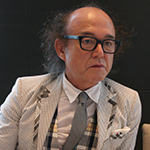IWP 2014/15 Asia Regional Competition Judges’ comments
2014.7.17 Andaz Tokyo
Below are the judges’ comments from the Asia regional competition of “The International Woolmark Prize,” an international fashion contest held by The Woolmark Company.
【Judges】
Angelica Cheung/Editor-in-Chief, Vogue China
Takehiko Suzuki/General Manager of Men’s & Sportswear, Isetan Mitsuksohi
Hajime Nakagawa/General Manager of Ladies, Jewellery & Watches, Children’s Wear, I, Isetan Mitsuksohi
Jessica Gomes/Model and David Jones Ambassador
Masafumi Suzuki/Editor-in-Chief, GQ Japan
Thakoon Panichgul/Fashion designer and owner of Thakoon
Angelica Cheung/Editor-in-Chief, Vogue China
|
|
Asia was always positioned as the buyer (market) in the fashion world until now, but recently the level of Japanese and other Asian designers is increasing, and I feel that Asia is gathering attention as an area that turns out designers who create new creations. Based on this background, I judged the participants by focusing on whether they are creating products with the global market in mind and also whether they have a continuous and strategic business concept. I feel that in recent years, there are more and more competent designers in Japan, as well as in China, Korea, and Hong Kong. I hope that we will see designers from the entire Asian region who will achieve worldwide success in the future. |
Isetan Mitsuksohi
|
Takehiko Suzuki/General Manager of Men’s & Sportswear, Isetan Mitsuksohi Hajime Nakagawa/General Manager of Ladies, Jewellery & Watches |
Jessica Gomes/Model and David Jones Ambassador
| I was impressed by the quality of the works presented at the competition, and I was able to feel ample energy and potential showing that Asia is becoming the center of fashion. I was very excited when I was first invited to be a judge, but at the same time I wondered what I could do as a model who was neither a designer nor an editor. What I gradually understood through the judging process was that my role was to judge based on what I myself would want to wear and what my friends would think. It was great to know the perspective of other judges, and I am very happy that I was able to participate as a judge. |
Masafumi Suzuki/Editor-in-Chief, GQ Japan
|
|
Each designer presented their work in a way that conveyed their feelings for the culture of their respective countries, and as a whole, there was a unique Asia-ness. It seemed that the contest made the designers think deeply about who they were, and I felt that their creations were of a different dimension from the global fashion trends. In the current age, where clothing is losing its systematic significance, there is a shift from clothes-making that called attention to the gender differences between men and women and physical beauty, which used to be mainstream in Western countries, to what can be called “one-gender” clothes-making, where there is little awareness of gender differences. This is something that was originally done by Japanese people, but I feel that this concept which is based in Asia is gradually becoming standard throughout the Western world. |
Thakoon Panichgul/Fashion designer and owner of Thakoon
|
|
IWP differs from other contests in that it imposes designers with the specific task of innovating wool. In addition, it is characterized by the fact that it looks at whether the brand is sustainable as a business and whether the designer is global-minded. As I am a designer myself, I know how difficult it is to present one’s passion in front of a judging panel comprising famous editors and retailers, but I felt that despite this, the participating designers were able to convey an extremely high level of craftsmanship. In recent years, more and more Asian designers are stepping out into the limelight, and I feel that Asia, with its large population, has a great amount of potential as a market. |






